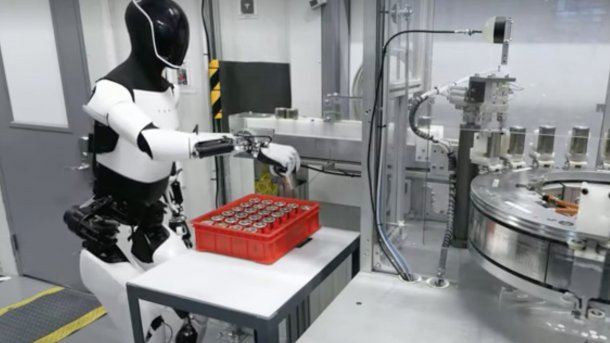Humanoid robots: Tesla wants to use Optimus Bot in automotive production in 2025
Elon Musk plans to use Tesla's Optimus Bot in electric car production in 2025. It should also be available to other companies in 2026.

Tesla's Optimus Bot sorts battery cells into a box for testing.
(Image: Tesla (Screenshot))
Tesla boss Elon Musk continues to drum up publicity for his humanoid robot Optimus Bot. Musk promises that the robot will be working in Tesla's electric car production from 2025. This was revealed in a post by Elon Musk on X (formerly Twitter) on Monday. However, the humanoid Optimus Bot robots will only be produced in small quantities for this purpose. The robot should then be available for other companies in 2026.
Musk had already indicated at the Tesla Annual General Meeting in June that more than 1,000 units of Tesla's Optimus humanoid robots could be working at Tesla by 2025. The first robots were to be used in production by the end of 2024. This will probably not happen after all. For the time being, the Optimus bot will continue to work in production on a trial basis. At the moment, it is still (very leisurely) sorting battery cells into boxes - not really a sensible task for a humanoid all-purpose robot.
Big plans
Before the Optimus Bot can carry out more demanding tasks, it still needs to be developed further, i.e. made more intelligent, so that it can learn new tasks as quickly as possible and carry out certain activities on demand. Musk promises that it will be ready by 2026. Then, according to Musk's latest plan, Optimus will be produced in such numbers that it can also be offered to other companies.
Musk is planning a sales price of around 20,000 US dollars, with production costs of around 10,000 dollars. The market for humanoid robots is estimated at one billion units per year, Musk said in June. Tesla wants to secure around 10 percent of the pie and make a profit of one trillion dollars a year. Incidentally, the Optimus Bot should also make Tesla the most valuable company in the world.
However, the plans seem to be a little too grandiose. Tesla is apparently not yet making any real progress in developing the Optimus Bot with a certain amount of intelligence. The robot should preferably learn from videos showing people carrying out industrial activities, then adapt them and become active itself.
Other robotics companies have an advantage
Other companies, such as UBTech with its Walker S and Agility Robotics with Digit, are already further ahead. This is probably one of the reasons why Musk is now pushing the Optimus Bot and making it attractive to investors in order to avoid falling even further behind other robotics companies. UBTech, for example, is already using its humanoid robot Walker S in the production of electric car manufacturer Nio. Digit is already officially working for the logistics company GXO Logistics.
Other robotics companies are about to deploy their humanoid robots in factories, such as Figure the Figure 01 at BMW and Apptronik its Apollo at Mercedes-Benz. However, the companies are still in the process of finding out exactly which tasks the humanoid robots are suitable for in production.
(olb)